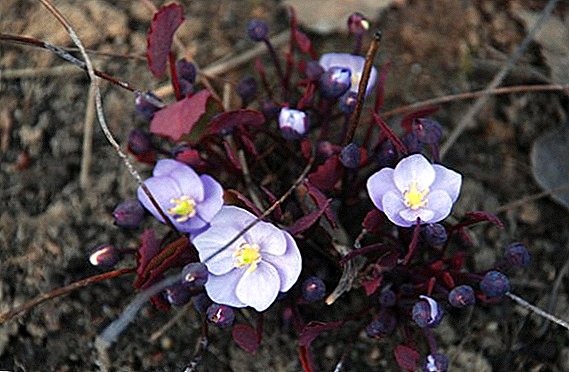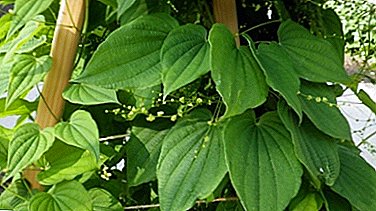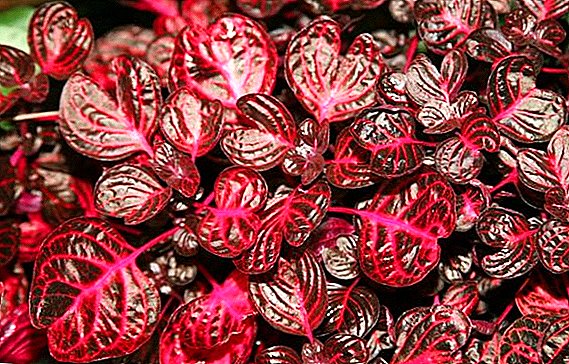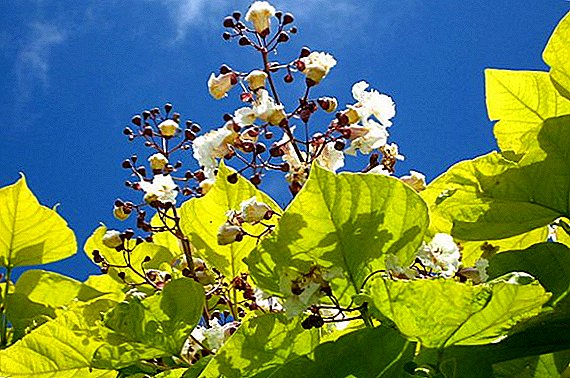 More recently, on the territory of European latitudes, a beautiful tree with large bright green leaves and long pods appeared - catalpa. Native to this amazing plant are the countries of America, China and Japan. In the area of natural habitat, he was dubbed the "tree of happiness", because for the locals, since the Mayan times, it has become not just a source of oxygen, a garden decoration and an ingredient for traditional medicine recipes, but also a special symbol that carries faith, joy and warmth . In this article we will talk about this amazing plant, its features, use, beneficial properties and contraindications to use.
More recently, on the territory of European latitudes, a beautiful tree with large bright green leaves and long pods appeared - catalpa. Native to this amazing plant are the countries of America, China and Japan. In the area of natural habitat, he was dubbed the "tree of happiness", because for the locals, since the Mayan times, it has become not just a source of oxygen, a garden decoration and an ingredient for traditional medicine recipes, but also a special symbol that carries faith, joy and warmth . In this article we will talk about this amazing plant, its features, use, beneficial properties and contraindications to use.
Biological description
Catalpa (Catalpa) - deciduous or evergreen trees or shrubs, reaching a height of 25 meters in natural conditions and about 10 as decorative. These plants botany refers to family Bignoniyevyh. They have the unusual shape of thick leaves (broadly ovate or heart-shaped), which form a very dense massive dome. The foliage never turns yellow, even in the autumn season. The bark of the tree is thick, cracked and has a gray-brown tint.
These plants botany refers to family Bignoniyevyh. They have the unusual shape of thick leaves (broadly ovate or heart-shaped), which form a very dense massive dome. The foliage never turns yellow, even in the autumn season. The bark of the tree is thick, cracked and has a gray-brown tint.
Did you know? The peculiarity of the structure of the catalpa trunk gave her some more unusual nicknames: "elephant ears" or "pasta tree".
This is a hermaphroditic plant. In the warm season, the representatives of the genus will surely delight with delicate pale pink or peach flowers. They have the shape of a bell and a bright pleasant aroma. The inflorescences are very large - up to 2.5 centimeters. In Europe, flowering continues for two months - June-July: it is very similar to the popular chestnut, but more abundant. Some people compare these flowers with delicate orchids. Catalpa gives fruit after pollination. This is a magical honey plant.
The genus includes 13 species, the most popular of them are Catalpa syringaefolia and Catalpa longissima. 
Chemical composition
Today, biologists have not fully studied the chemical composition of the tree of happiness. Only some features of catalpa are known. The bark contains special resins and tannins, or tannins. It is believed that the resin mainly gives the plant useful properties. Foliage is rich in monoterpenic glycosides.
Fruit seeds, namely oil of eleostearic acid, are quite useful components. Interestingly, almost a third of the seeds consist of this oil. It is widely used in the manufacture of building materials, most often paints and varnishes. Catalposide is found in leaflets and the cortex, it is a strong diuretic substance. The composition of seeds also includes: lipids, proteins, cellulose and ash.
Did you know? In Ukraine, there is a single catalpa, legally protected - botanical monument of natural state significance. It is located in the town of Chortkov on Shevchenko Street and has a special cultural value.
Based on the chemical composition of the tree, it can be concluded that, depending on the application, catalpa can bring both benefit and harm to the human body and the environment. 
Medicinal properties
Almost all plants have properties that can be used to treat various diseases. The tree of happiness is not an exception.
His bark promotes digestion and improves metabolism. Fruits and leaves of catalpa can be used for cancer and problems with the respiratory tract - this will give a remarkable result and literally put the patient on his feet.
Broths of flowers are well suited for problem skin, and acne, acne and rash will leave you alone.
For the treatment of problem skin, traditional medicine advises to use products from chamomile, calendula, celandine, coltsfoot, burdock, marigolds, laurel, cress, yarrow, cornflowers, alokaziya, apricot, cornel, ivy.
Healing bark based tinctures will help with all kinds of inflammatory processes.
European scientists have found an extract in catalpa that can fight off diabetes mellitus. A few centuries ago, the Indians treated whooping cough and malaria with this plant. Today in China, the plant is widely used to fight worms.
Medicinal properties of catalpa are used in veterinary medicine. To prevent vitamin deficiency in pets, they are often given foliage catalps. Farmers argue that so cattle are really sick less.
Important! Catalpa roots have very poisonous properties, therefore, although they were used in ancient times, using the underground part of the plant is strictly prohibited on its own. The consequences can be deadly!

Recipes of traditional medicine
The people called catalpa "tree-doctor", and this is well deserved. It is a good ingredient that deserves application in a multitude of recipes of traditional medicine:
- Healing decoction of catalpa is easy to prepare. It will help get rid of skin diseases. It is necessary to take the bark and leaves of the tree, fill the pan with them by a third. Then we fill everything with clean water and set it on fire. It is necessary to boil the drug for 10 minutes and allow it to cool. Strain the liquid with sterile gauze. Take a decoction is one glass twice a day, if desired, with one teaspoon of honey. For best effect, you can wipe the affected skin with this medicine.
- Tincture from the seeds of the tree of happiness is good for problems with metabolism. For its preparation, it is necessary to soak the grains in warm water in a ratio of 1: 2 for 5-7 days. At this time, keep the mixture in a cold dark place. It is recommended to drink one tablespoon before meals 3-4 times a day. The course of treatment may not exceed two weeks.
- The solution for washing the wounds of the tree of happiness will be useful to everyone. To make it, you just need to chop the leaves of the tree into small pieces, pour boiling water and let them stand for a day. Universal antiseptic ready!
Important! Folk remedies of catalpa may be incompatible with other drugs, so you need to consult with a specialist before preparing them.
Application in cosmetology
As already indicated earlier, the tree of happiness has a great effect on the skin. This property is used by modern cosmetology. In this regard, catalpa is an incredibly promising plant.  Fatty acid composition of triacylglycerols of macaroni tree oil moisturizes the skin, evens out its color, and in a mixture with other cosmetological substances cleans well. Flowers of the plant give a magical aroma, so some cosmetics of famous brands smell exactly catalpa. This oil can be found in the composition of many means of the fashion industry.
Fatty acid composition of triacylglycerols of macaroni tree oil moisturizes the skin, evens out its color, and in a mixture with other cosmetological substances cleans well. Flowers of the plant give a magical aroma, so some cosmetics of famous brands smell exactly catalpa. This oil can be found in the composition of many means of the fashion industry.
Preparation of medical raw materials
The method and time of harvesting raw materials for home use depends on what part of the tree you need. Bark can be collected all year round. Some traditional healers cut it in advance and dry it. There are even legends that the bark of a tree should be collected on the day of the angel of the person whom it will then heal. Other people prefer to tear the ingredient from the tree as needed.
The leaves are the same story, but if you want to add them to tea, be sure to wash and dry. Otherwise, they will not brew properly. In addition, the tree is mostly deciduous, so for the winter this ingredient, respectively, should be reserved for the summer. After complete drying, keep the foliage in a cloth bag in a dry place. So she can "breathe" and not spoil.
Medicinal tea is made from cherry, safflower, hibiscus, princes, lemongrass, rosemary, acacia, hazelnut, cloudberries, lavender, mint, lemon balm.
Catalpa flowers be sure to dry before use. They are best collected at the end of June, spread out on a paper towel in the sun. So in a few days they will be ready. We keep inflorescences in the same way as foliage.
An important point: the bark, leaves and flowers must be intact by insects, diseases or fungi. Be careful not to get poisoned. 
Wood use
Catalpa wood very strong and resistant to moisture. That is why it is used for the manufacture of bath furniture, as well as products for external use: gazebos, swings, benches. Thanks to tightly woven cellulose fibers, catalpa products will serve a rather long period. In addition, the color of the trees is quite versatile - brown-gray. It will perfectly fit into any interior, and in the country style it can become the basis for the design of a room.
The wood is so beautiful that it does not require painting - it is enough to varnish it. The plant is suitable for wood carving art. Experienced masters have long praised him, and their admirers admire. Of course, the impressive size of the trunk and the hardness of the tree make it possible to make any masterpiece of it.
Catalpa furniture is a very relevant and sought-after product, but unfortunately expensive. Many people who know that this is not just a plant, but a real tree of happiness, do not spare money. After all, who would not wish to settle joy and good fortune into their home with beautiful, practical, comfortable, durable and high-quality furniture! 
Contraindications and harm
Like all plants, catalpa has, in addition to its beneficial properties, also harmful.
Firstly, even a short contact with a tree can cause severe allergies, rash, cough.
Secondly, the use in folk medicine of any parts of the tree is not recommended for people who have adrenal gland diseases and individual intolerance biological components of the plant. It was previously indicated that the roots of the tree of happiness are extremely poisonous, so it’s better not to touch them with your hands. If you need to transplant plants, then do it only with gloves.
And the last thing - for pregnant women, treatment with folk remedies is strictly forbidden without consulting a doctor! Catalpa may well cause hypertonicity of the uterus, detachment of the placenta, premature labor and miscarriage. Be careful and cautious, because you are responsible not only for your own health, but also for the well-being of the future baby.
Traditional medicine is a very effective remedy for many ailments, but in no case should it be abused.












